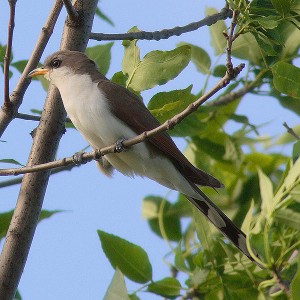Stop me if you’ve heard this one before. The federal government wants private landowners in arid western states to help identify and designate important habitat for a certain bird species, so the land can be protected against development, and thereby save the bird from some dire fate.
 If that sounds familiar, it’s because we have been there before. Or as Yogi Berra supposedly said, “It’s like déjà vu all over again.” However, this time it is not about sage grouse, but a less common (in Western Colorado) bird called the yellow-billed cuckoo – the original mascot of Cocoa Puffs cereal. Farmers, ranchers, and local officials are skeptical, because so many are frustrated with the notion that environmental protection always seems to require restricting human activity.
If that sounds familiar, it’s because we have been there before. Or as Yogi Berra supposedly said, “It’s like déjà vu all over again.” However, this time it is not about sage grouse, but a less common (in Western Colorado) bird called the yellow-billed cuckoo – the original mascot of Cocoa Puffs cereal. Farmers, ranchers, and local officials are skeptical, because so many are frustrated with the notion that environmental protection always seems to require restricting human activity.
Many observers didn’t even notice when the Fish and Wildlife Service listed the bird as threatened last fall, because we are in the midst of 4-year whirlwind of new endangered listings, the result of a lawsuit requiring decisions on more than 800 species. The yellow-billed cuckoo has been on the wish list of national environmental organizations for 30 years. Their first petition asking the government to put it on the endangered list was filed in the mid-1980s. At that time, the best scientific analyses concluded that an endangered finding was unwarranted, because the bird was commonly found across most of the continent, from southern Canada to northern Mexico and in nearly all U.S. states. The cuckoos were found to be less common in the arid West because their preferred habitat is riparian areas and wetlands along riverbanks. So the environmental groups began asking for the Western population of cuckoos to be classified as a different “subspecies” than its eastern siblings. There is no scientific basis for that, so ultimately the feds separated it on purely geographic grounds, designating a western “distinct population segment” instead. That provides the legal tool they need for separate listings in one part of the country, even though a species may be common elsewhere.
The government spent bags of public money over the years studying cuckoos and identifying potential habitat, supposedly to prevent the bird from becoming endangered in the future. Now they want to designate critical habitat in places like my hometown in Mesa County, Colorado. That may sound reasonable to some, except that these birds do not actually live in Mesa County.
I know that because the Fish and Wildlife Service did this exercise before, in 2008 when it commissioned a study by the Rocky Mountain Bird Observatory, in cooperation with the Colorado Division of Wildlife. The study, “Yellow-Billed Cuckoos in Western Colorado,” detailed surveys conducted throughout the region and identified both potential habitat and actual birds. It found that Mesa County has lots of cottonwoods (a favorite of cuckoos), as well as tamarisk, Russian olive and several other non-native species we have been working for years to eliminate. Although the area was said to be prime habitat for the yellow-billed cuckoo, the on-ground survey found only a couple birds in Montrose and Moffat Counties and a handful in Delta, but not a single bird in Mesa County. Not one.
Today one Fish and Wildlife Service employee apparently claims to have seen a yellow-billed cuckoo in Mesa County, and one photograph purports to “prove” it, though the picture shown to County Commissioners was not dated or labeled to show its location. Lots of folks still remember examples of such evidence being planted by the agency, whereas the one genuine scientific survey found otherwise, so credibility is an issue.
Some local officials are in the process of another study to map the habitat and document the birds (or lack of birds) in their communities. That may be the smart move because it is likely to confirm the conclusions of the earlier study, and of numerous farmers who know better than federal officials what birds they see on their property. More scientific information is always a good idea.
Many of us believe we should do everything we can to prevent endangered listings and to recover already listed species, including habitat protection (especially if it’s voluntary). But there is a problem here. We have seen firsthand the contempt with which the federal government views local efforts. The States of Colorado, Utah and a number of counties are suing the feds for ignoring such cooperation and breaking its promise not to list the Gunnison sage grouse.
The ink is barely dry on the federal decision to list the grouse as threatened, one of the worst broken promises in the history of conservation. Coloradans supported the Gunnison Ranchlands Legacy project for 20 years, culminating in an agreement with the government allowing landowners to enroll in a habitat management program, with the assurance that their farming practices would not get them into trouble if grouse nests are accidentally disturbed. As a result, the species was not listed, and local participation surpassed any similar program anywhere. All of this investment and local participation was made with the clear understanding that the species would not be added to the federal endangered list.
Coloradans invested over $50 million of state, local, and private money in conservation easements to preserve the grouse, saving over 64,000 acres of habitat. All that effort depended on trusting the government to do what it says, and landowners and local governments relied on that trust for a generation. Yet despite healthy and growing grouse population, the government ignored its own promises and listed the species anyway, endangering not only the bird’s future, but especially the future of such cooperation.
People in the West care about wildlife species, including both the sage grouse and the yellow-billed cuckoo. They happily invest time and resources to keep such birds from going extinct. But in the final analysis, these federal activities are not about saving birds; they are only about the listing itself. The agency loves to add new species to the list, and has been doing so for years. Today there are 2,220 species the government says are threatened or endangered, and in the entire 40-year history of the Endangered Species Act we have successfully recovered and removed from the list less than one-half of one percent. That demonstrates rather conclusively that listing – not recovery – is their primary goal. So in 2011 when environmental groups sued the government for not making listing decisions fast enough, Interior was happy to settle out of court, agreeing to make final decisions on hundreds of new listings – and paying the environmental groups’ legal fees. Unfortunately for the birds, the process is driven more by lawsuits and money than by science.
 In this case, the science has not changed in the 53 years since General Mills introduced Sonny, the yellow-billed bird that’s “Cuckoo for Cocoa Puffs,” in 1962. The birds west of the Continental Divide are still biologically identical to those on the east side; they are still not in danger of extinction; and there are still none in my home town.
In this case, the science has not changed in the 53 years since General Mills introduced Sonny, the yellow-billed bird that’s “Cuckoo for Cocoa Puffs,” in 1962. The birds west of the Continental Divide are still biologically identical to those on the east side; they are still not in danger of extinction; and there are still none in my home town.
Birds fly and cuckoos are migratory, so it is possible that they stopover anywhere there is riparian habitat along rivers and streams. So the primary question remains: should we designate much of the lower Colorado River and its tributaries as critical habitat for a bird that is not native to the area, and thereby provide federal veto power over land use decisions on private land? The government has tried to assure the Commissioners that it will not do that. “Trust us,” they say, “We will not use this listing to regulate water, farming, transportation, construction, and other existing economic activity.”
Sadly, that trust has already been broken. The same agency that once promised not to list the Gunnison sage grouse also once said the yellow-billed cuckoo did not warrant listing, yet here we are again. Small wonder that the very word “cuckoo” means crazy.




Comments on this entry are closed.